Key takeaways:
- JavaScript frameworks like React, Angular, and Vue.js significantly enhance web development efficiency and organization.
- Choosing a framework involves considering factors such as learning curve, project requirements, and long-term viability.
- Hands-on projects and community engagement are critical for mastering frameworks and deepening understanding.
- Regularly revisiting fundamental concepts is essential to maintain clarity and confidence while learning advanced features.
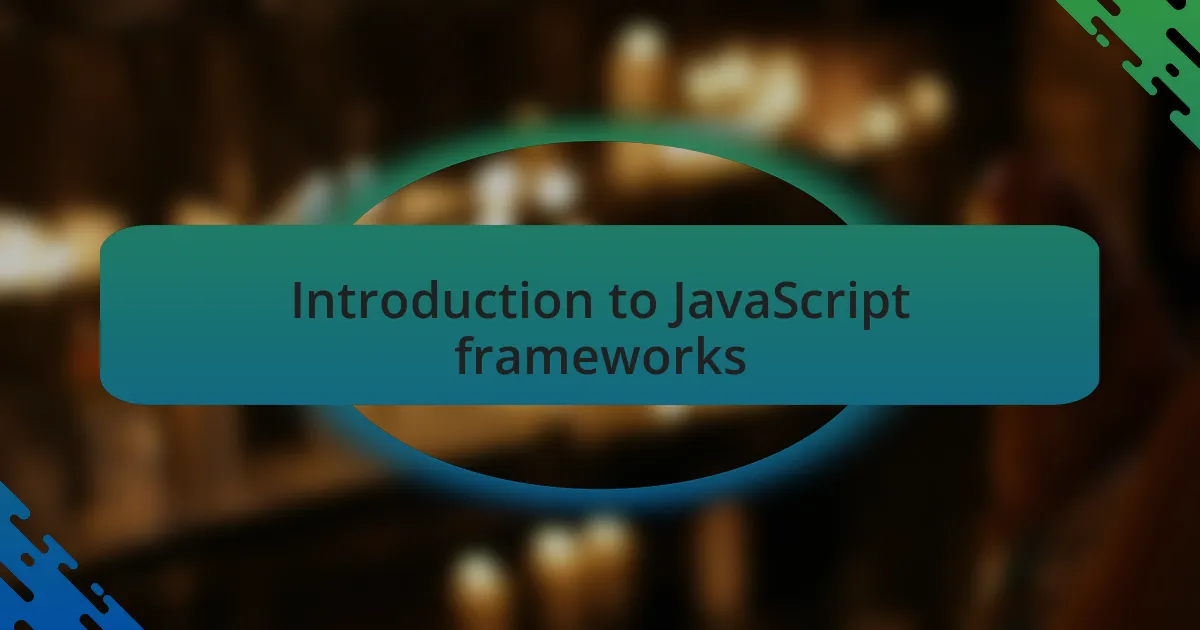
Introduction to JavaScript frameworks
JavaScript frameworks have transformed the way we build web applications, streamlining development and enhancing user experiences. I still remember my first encounter with a framework; it felt like a breath of fresh air compared to vanilla JavaScript. Suddenly, tasks that used to take hours were accomplished in mere minutes.
There’s something exhilarating about leveraging frameworks like React, Angular, or Vue.js. They offer a structured way to organize code, which makes life so much easier, especially on larger projects. Have you ever felt the chaos of managing many components and views? These frameworks bring a sense of order and predictability that can be incredibly rewarding and even inspiring to work with.
For anyone new to web development, diving into the world of JavaScript frameworks might feel daunting. However, this is where the real magic starts. Reflecting on my journey, I can assure you that embracing these tools leads to greater efficiency and creativity. The moment you grasp their capabilities, you’ll find yourself wondering how you ever got by without them.
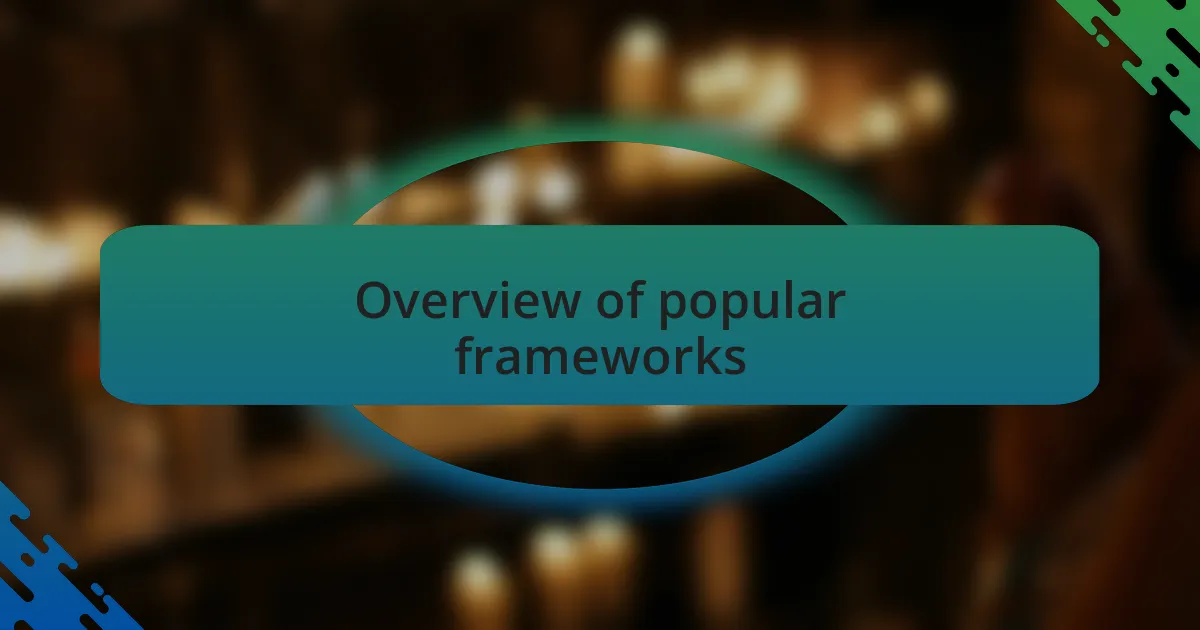
Overview of popular frameworks
React is often my go-to framework, and for good reason. It allows for the creation of dynamic components with relative ease, and I still recall the thrill of building my first single-page application with it. The virtual DOM concept was an eye-opener for me, drastically improving my app’s performance and responsiveness. Isn’t it fascinating how a concept can completely change your way of thinking about application performance?
Then there’s Angular, which I initially found quite overwhelming. Its robust structure and strong opinionated guidelines can feel restrictive at first. But once I got the hang of its powerful features, like dependency injection, I appreciated the depth it added to my projects. I remember the satisfaction of debugging a complex feature, knowing that Angular’s tools were right there to support me. Have you felt that moment when everything clicks into place?
Vue.js is another favorite of mine, particularly for smaller projects. I love how intuitive it is, enabling rapid prototyping without a steep learning curve. I still remember whipping up a quick dashboard using Vue, and marveling at how easy it was to bind data to UI components. It made me realize that simplicity doesn’t compromise power; in fact, it can often enhance creativity in development.
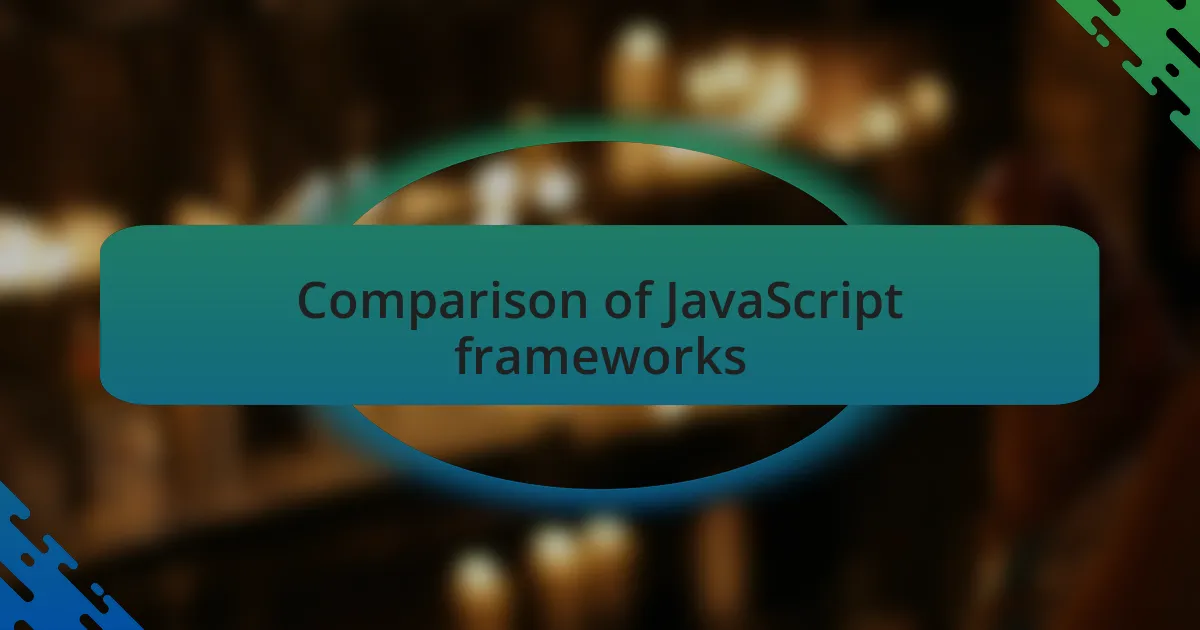
Comparison of JavaScript frameworks
When comparing JavaScript frameworks, I often reflect on the balance between power and simplicity. I remember a project where I mixed React and Vue.js components, and I was surprised by how distinct their philosophies were. React’s flexibility is exhilarating but can lead to indecision, while Vue’s structured approach provided a comforting stability, almost like a well-organized toolkit for my development tasks. Does the framework you choose make you feel empowered, or does it sometimes feel like it’s holding you back?
I’ve also noted that community and ecosystem support can heavily influence my framework choice. For instance, React has a vast library of extensions, which really helped me build a sophisticated feature quickly. However, I once struggled to find a solution while working with Angular, feeling a bit alone in a more niche community. It’s during those moments that I found myself asking, “How important is community when you hit a roadblock?”
Lastly, I believe performance should be a top priority in any framework comparison. In one instance, I was working on a real-time application where load times were critical. I chose React, and integrating it with WebSocket was seamless, leading to an incredible user experience. Watching users interact without lag felt rewarding, reminding me that the underlying technology can truly make or break user engagement. Have you ever experienced that rush when your code performs better than expected?

Factors to consider when choosing
One significant factor I consider is the learning curve associated with a framework. When I first encountered Angular, I felt overwhelmed by its complex architecture and extensive documentation. I often found myself wondering, “Can I really invest this time to master it?”, especially when simpler frameworks like Vue seemed more accessible to dive into right away.
Another critical aspect is the project requirements. A few years ago, I worked on an e-commerce platform that demanded high scalability. I chose Node.js with Express to manage the backend and React for the frontend, which allowed me to create a dynamic user experience. Did I ever doubt that choice? Absolutely. But the performance gains and the ability to effortlessly handle concurrent users reassured me that I made the right decision.
Lastly, I can’t stress enough the importance of long-term viability. I once jumped on a trendy framework that quickly lost traction, leaving me with a project that felt stranded. It made me realize that I should question, “Will this framework still be supported and relevant in a couple of years?” Understanding the lifecycle and commitment of the framework can save developers from future headaches.
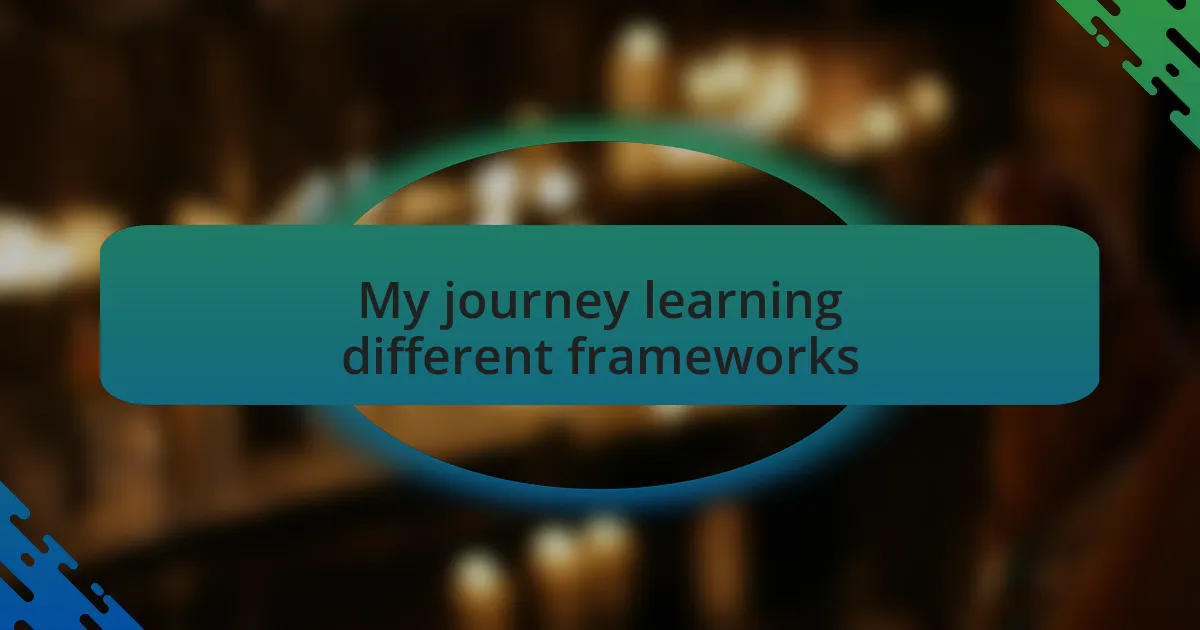
My journey learning different frameworks
As I transitioned into the world of JavaScript frameworks, I remember feeling like a child entering a candy store—so many options, yet so much choice paralysis. I dabbled in Angular first, and the complexity made my head spin. I can still recall those late nights spent glued to the screen, wrestling with dependency injection and the component lifecycle, pondering if I was cut out for this.
Then, I stumbled upon React, and everything clicked. The component-based architecture felt natural, almost like building with Legos. I vividly recall the joy of creating my first reusable component; it was a eureka moment that made me appreciate the power of modular coding. I nearly shouted in delight when I saw how changing a single piece updated the entire app— “Why didn’t I start here?” I wondered.
Eventually, I explored Vue, and it felt like coming home. The gentle learning curve was refreshing, allowing me to focus on project features rather than getting mired in syntax. I appreciated its flexibility and the simplicity of data binding; it made me question why I had ever stressed over figuring out bigger frameworks. There’s something incredibly liberating about finding the right fit, isn’t there?
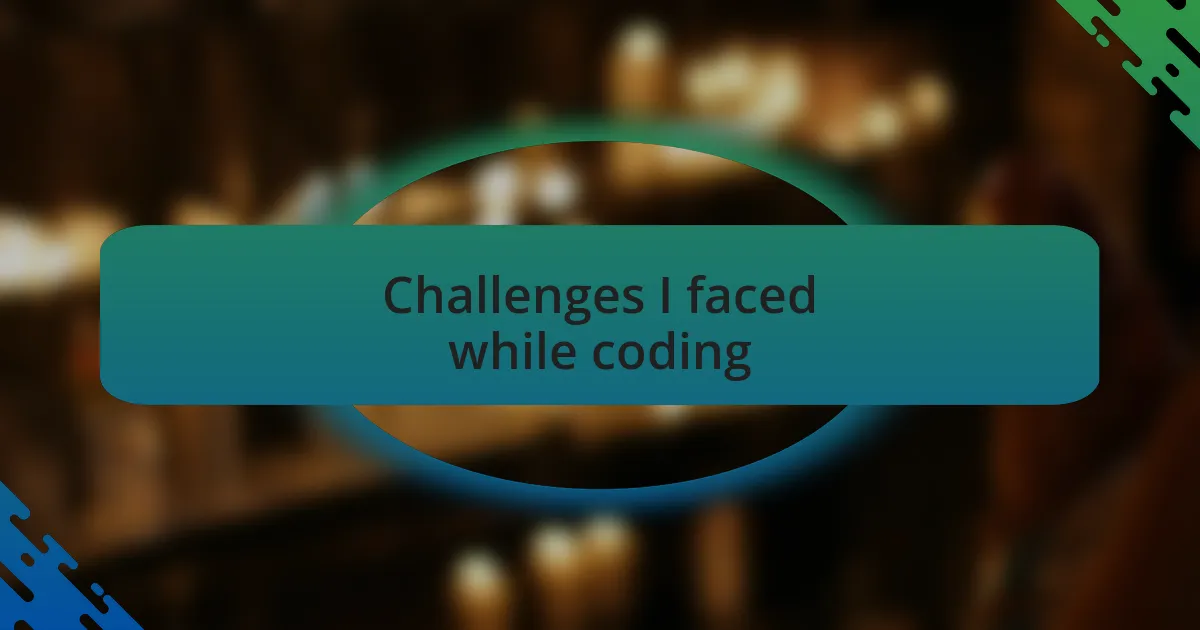
Challenges I faced while coding
As I dove deeper into JavaScript frameworks, one persistent challenge was the overwhelming amount of documentation and resources available. At times, I felt like I was lost in a sea of information, trying to sift through what was relevant and what was noise. I recall spending hours watching tutorial videos, only to find that the example projects didn’t align with my personal goals, leaving me more frustrated than enlightened.
Another hurdle I faced was state management, particularly in larger applications. In one project, I remember being paralyzed by indecision, unsure whether to use Redux or the built-in state management features of Vue. It felt like I was sacrificing either simplicity or scalability. After some trial and error, I learned that the right choice wasn’t always clear-cut, and sometimes a bit of experimentation is necessary to find the best solution for the specific needs of a project.
Performance optimization became another thorn in my side. I vividly remember the sinking feeling when I noticed my React app lagging during data fetches. It prompted a deep dive into techniques like memoization and lazy loading. Those moments were eye-opening; they taught me that mastering a framework also involves understanding how to keep applications running smoothly. Was it frustrating at times? Absolutely. But, in hindsight, those challenges made me a more thoughtful developer.
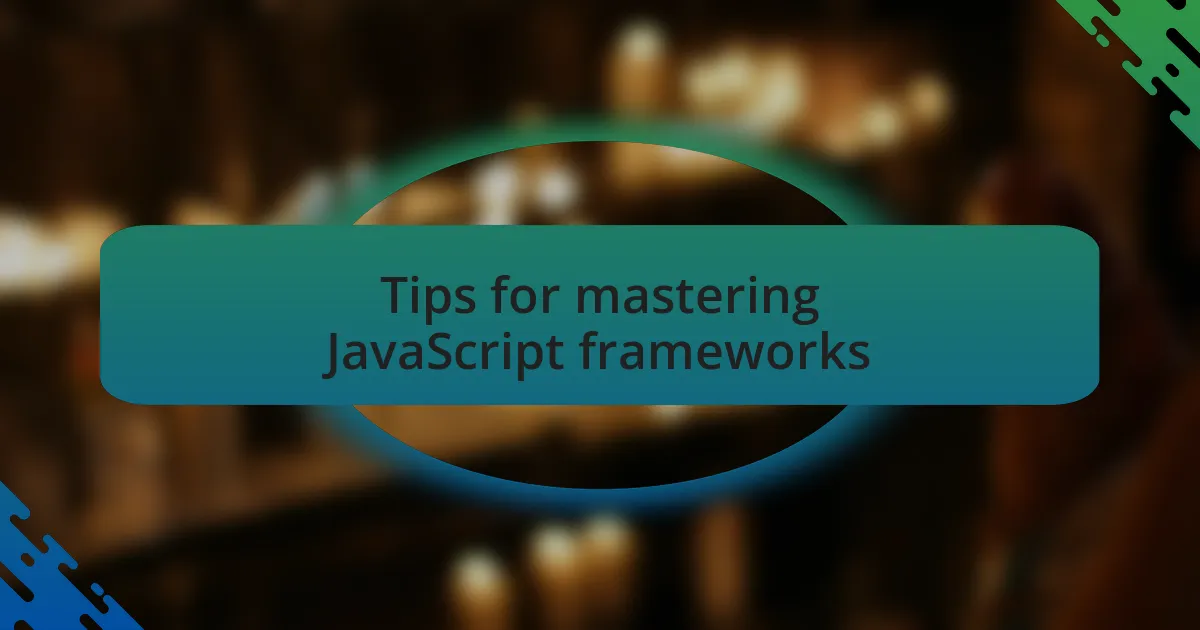
Tips for mastering JavaScript frameworks
When it comes to mastering JavaScript frameworks, I found that building small, hands-on projects is incredibly effective. I remember starting with a simple to-do list app using Angular, and that experience was a revelation. It wasn’t just about writing code; it was about seeing how components interacted, how data flowed, and how the framework made my life easier—or sometimes, more complicated. Have you ever built something from scratch only to have it teach you more than any tutorial? That’s the magic of practical experience.
Another key tip I discovered is the importance of community and collaboration. I once joined a local meetup for developers focused on React, and the conversations that unfolded were invaluable. Sharing challenges and solutions with others not only deepened my understanding but also kept me motivated through tough times. Engaging with a community helps to demystify more complex concepts and can turn topics that seem daunting into manageable, relatable ones. Have you considered tapping into online forums or local groups?
Lastly, I cannot stress enough the value of regularly revisiting the fundamentals. I had a moment with Vue.js where I got lost in advanced features and forgot the basics. I took a step back and revisited concepts like directives and the Vue instance itself. It was like shining a light in a dark room; I quickly regained clarity and confidence. Isn’t it easy to overlook the basics when we’re chasing the latest trends? Mastering frameworks requires a solid foundation, and sometimes, going back to square one is the best path forward.